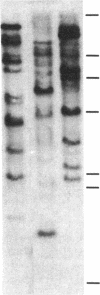Abstract
Creatine kinase (CK; EC 2.7.3.2) plays an important role in energy metabolism in brain and muscle. Expression of CK isoenzymes is regulated during development and is tissue specific. To define the structures of canine CK isoenzymes and to elucidate the mechanism of regulation in their expression, CK cDNA clones from dog myocardium were isolated. Myocardial CK mRNA is predicted to encode a protein of 381 amino acids. The nontranslated regions of the mRNA comprise at least 38 bases at the 5' end and exactly 345 bases before the poly(A) tail. Partial protein sequences of dog muscle (M) CK and brain (B) CK subunits were determined and compared with the derived amino acid sequence of the myocardial enzyme and of M CK subunits of other species. The M CK subunits from different species share a very high degree (83-96%) of sequence identity. Dog M and B subunits share extensive sequence identity (74%), a degree of similarity not previously suspected. Southern blot analysis suggests that a CK gene family exists. These observations imply that evolutionary changes in the M CK subunit structure are constrained by the need for preservation of functional properties other than the kinase activity. This conservation is consistent with the possibility that the M subunit plays a structural role in cardiac and skeletal muscle.
Full text
PDF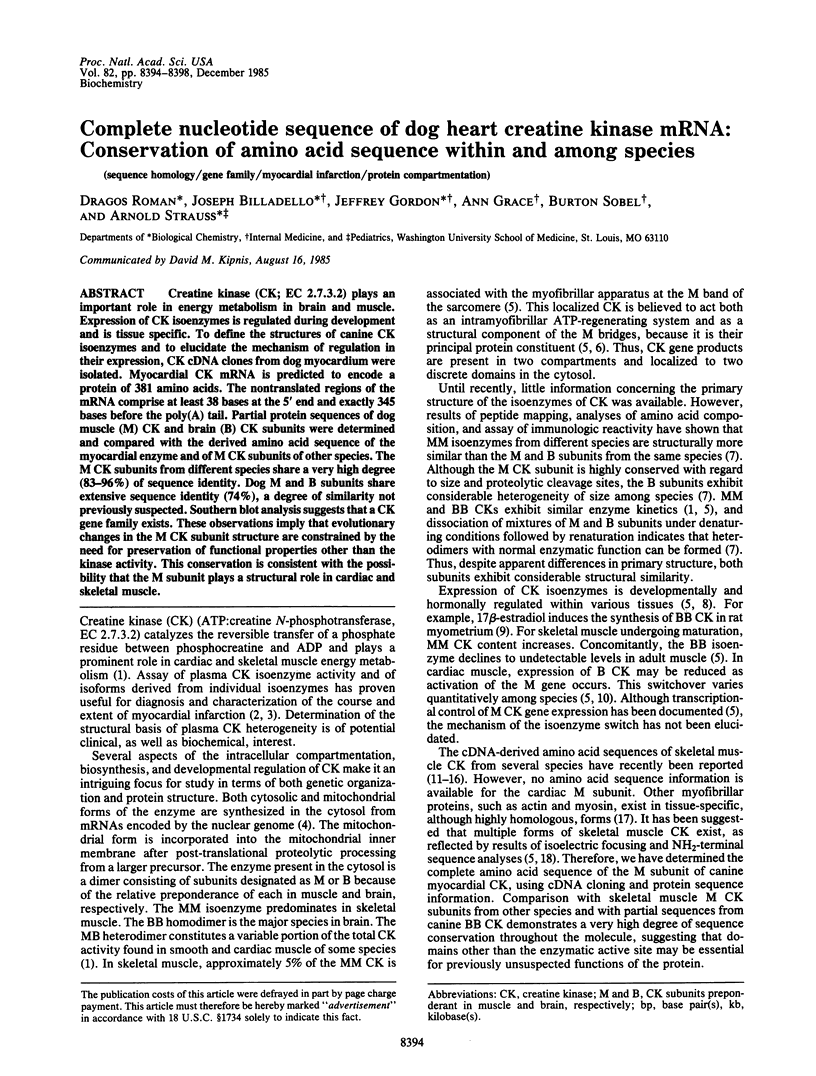
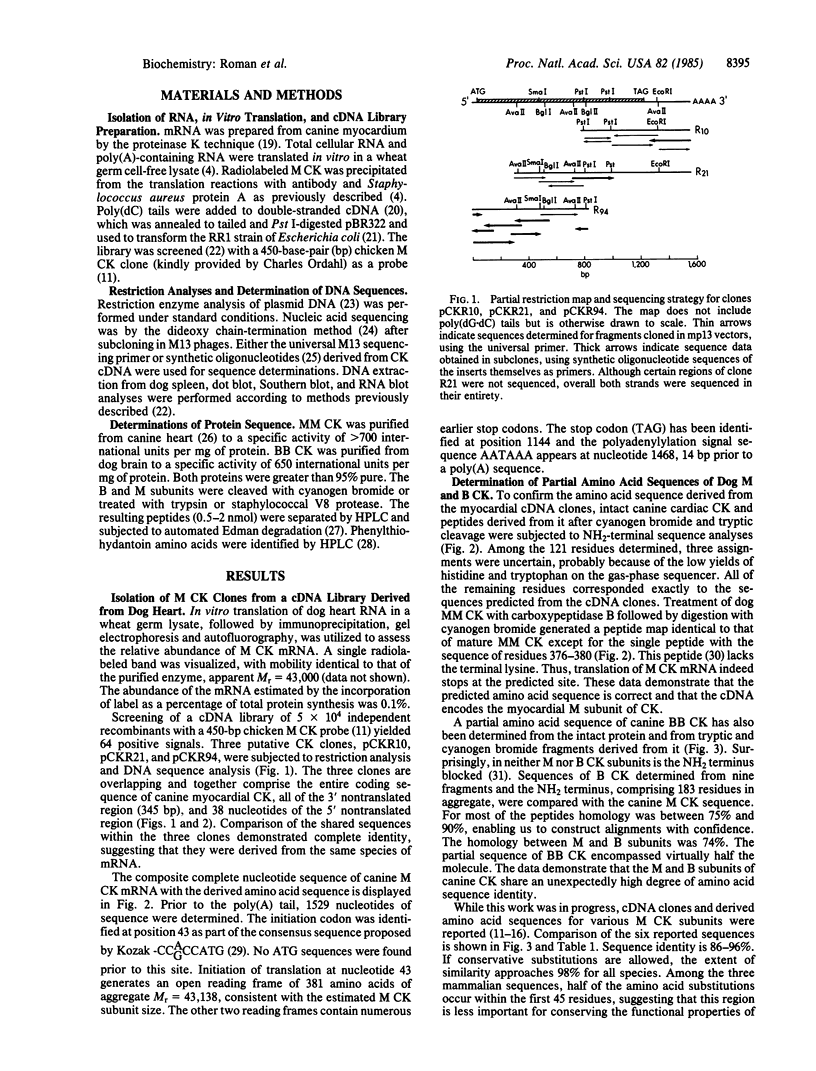
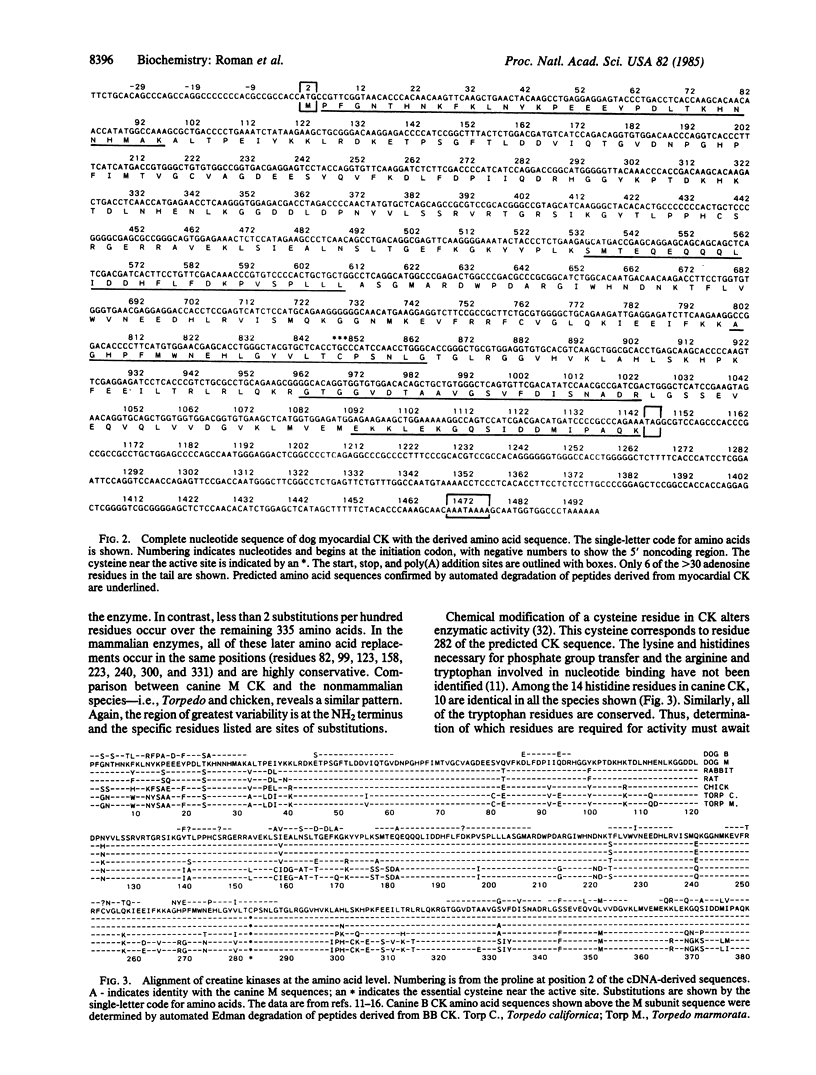
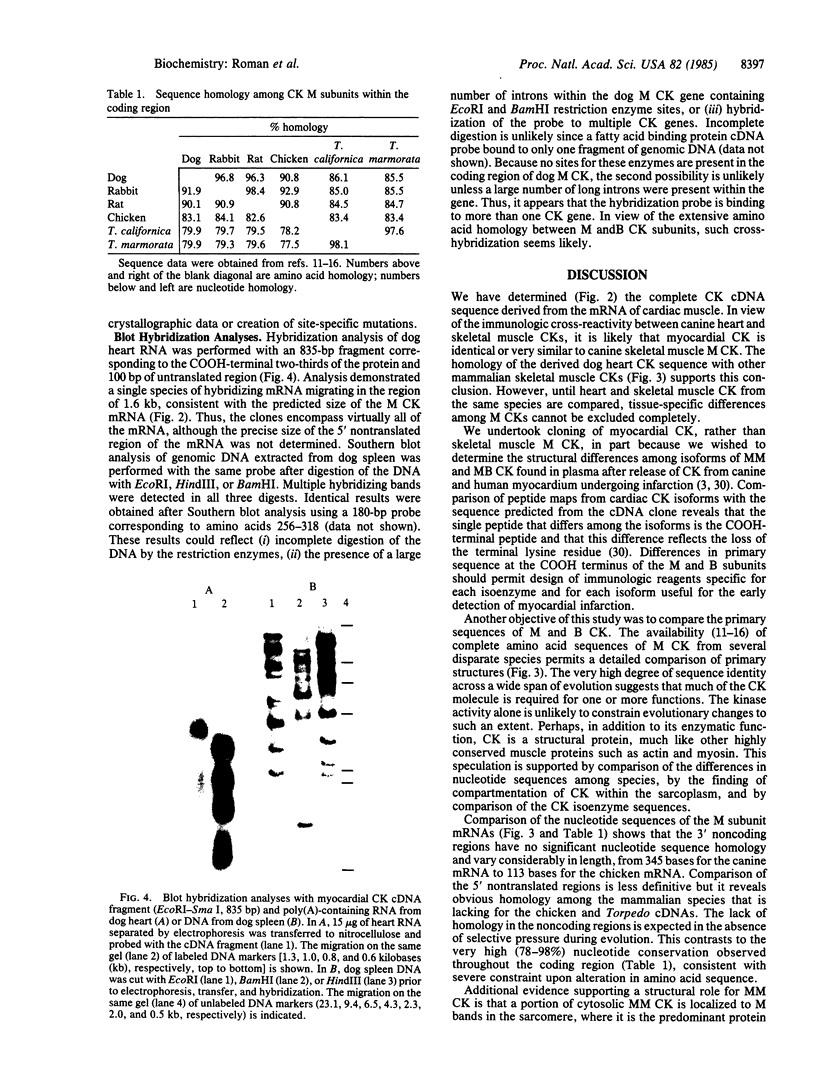
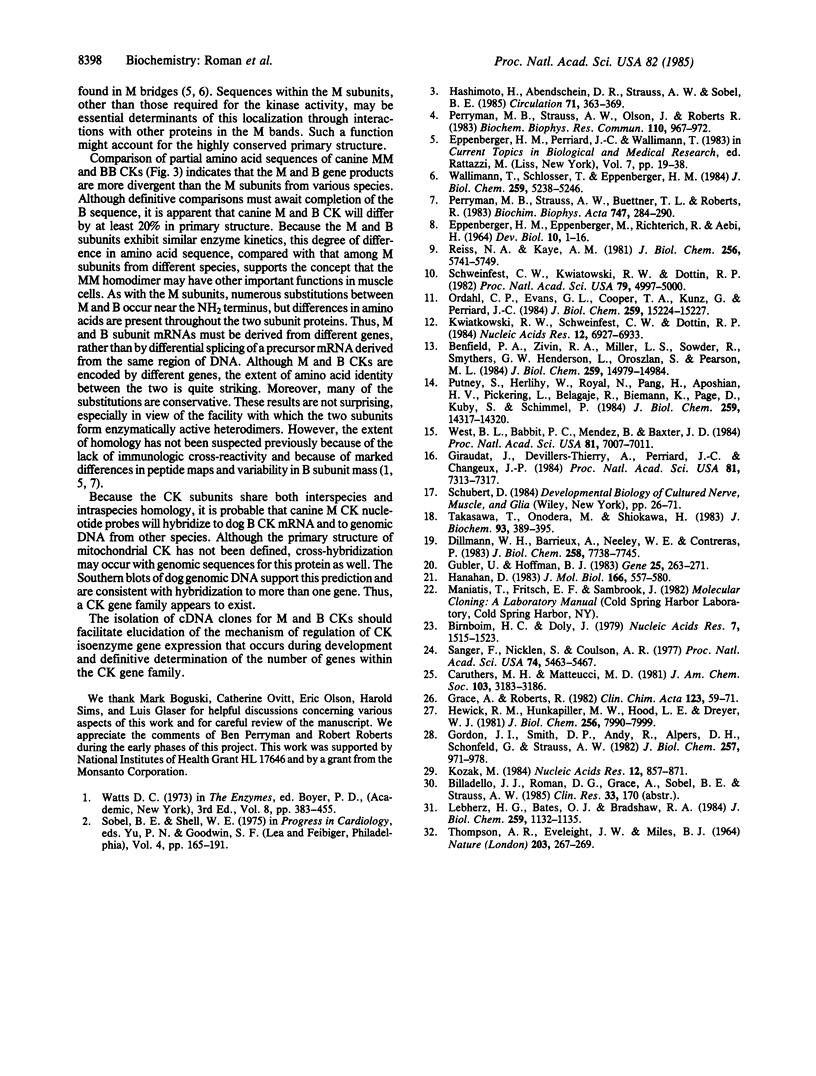
Images in this article
Selected References
These references are in PubMed. This may not be the complete list of references from this article.
- Benfield P. A., Zivin R. A., Miller L. S., Sowder R., Smythers G. W., Henderson L., Oroszlan S., Pearson M. L. Isolation and sequence analysis of cDNA clones coding for rat skeletal muscle creatine kinase. J Biol Chem. 1984 Dec 10;259(23):14979–14984. [PubMed] [Google Scholar]
- Birnboim H. C., Doly J. A rapid alkaline extraction procedure for screening recombinant plasmid DNA. Nucleic Acids Res. 1979 Nov 24;7(6):1513–1523. doi: 10.1093/nar/7.6.1513. [DOI] [PMC free article] [PubMed] [Google Scholar]
- Dillmann W. H., Barrieux A., Neeley W. E., Contreras P. Influence of thyroid hormone on the in vitro translational activity of specific mRNAs in the rat heart. J Biol Chem. 1983 Jun 25;258(12):7738–7745. [PubMed] [Google Scholar]
- EPPENBERGER H. M., EPPENBERGER M., RICHTERICH R., AEBI H. THE ONTOGENY OF CREATINE KINASE ISOZYMES. Dev Biol. 1964 Aug;10:1–16. doi: 10.1016/0012-1606(64)90002-8. [DOI] [PubMed] [Google Scholar]
- Giraudat J., Devillers-Thiery A., Perriard J. C., Changeux J. P. Complete nucleotide sequence of Torpedo marmorata mRNA coding for the 43,000-dalton nu 2 protein: muscle-specific creatine kinase. Proc Natl Acad Sci U S A. 1984 Dec;81(23):7313–7317. doi: 10.1073/pnas.81.23.7313. [DOI] [PMC free article] [PubMed] [Google Scholar]
- Gordon J. I., Smith D. P., Andy R., Alpers D. H., Schonfeld G., Strauss A. W. The primary translation product of rat intestinal apolipoprotein A-I mRNA is an unusual preproprotein. J Biol Chem. 1982 Jan 25;257(2):971–978. [PubMed] [Google Scholar]
- Grace A., Roberts R. Improved procedures for purification of human and canine creatine kinase isoenzymes. Clin Chim Acta. 1982 Aug 4;123(1-2):59–71. doi: 10.1016/0009-8981(82)90114-0. [DOI] [PubMed] [Google Scholar]
- Gubler U., Hoffman B. J. A simple and very efficient method for generating cDNA libraries. Gene. 1983 Nov;25(2-3):263–269. doi: 10.1016/0378-1119(83)90230-5. [DOI] [PubMed] [Google Scholar]
- Hanahan D. Studies on transformation of Escherichia coli with plasmids. J Mol Biol. 1983 Jun 5;166(4):557–580. doi: 10.1016/s0022-2836(83)80284-8. [DOI] [PubMed] [Google Scholar]
- Hashimoto H., Abendschein D. R., Strauss A. W., Sobel B. E. Early detection of myocardial infarction in conscious dogs by analysis of plasma MM creatine kinase isoforms. Circulation. 1985 Feb;71(2):363–369. doi: 10.1161/01.cir.71.2.363. [DOI] [PubMed] [Google Scholar]
- Hewick R. M., Hunkapiller M. W., Hood L. E., Dreyer W. J. A gas-liquid solid phase peptide and protein sequenator. J Biol Chem. 1981 Aug 10;256(15):7990–7997. [PubMed] [Google Scholar]
- Kozak M. Compilation and analysis of sequences upstream from the translational start site in eukaryotic mRNAs. Nucleic Acids Res. 1984 Jan 25;12(2):857–872. doi: 10.1093/nar/12.2.857. [DOI] [PMC free article] [PubMed] [Google Scholar]
- Lebherz H. G., Bates O. J., Bradshaw R. A. Cellular fructose-P2 aldolase has a derivatized (blocked) NH2 terminus. J Biol Chem. 1984 Jan 25;259(2):1132–1135. [PubMed] [Google Scholar]
- Ordahl C. P., Evans G. L., Cooper T. A., Kunz G., Perriard J. C. Complete cDNA-derived amino acid sequence of chick muscle creatine kinase. J Biol Chem. 1984 Dec 25;259(24):15224–15227. [PubMed] [Google Scholar]
- Perryman M. B., Strauss A. W., Buettner T. L., Roberts R. Molecular heterogeneity of creatine kinase isoenzymes. Biochim Biophys Acta. 1983 Sep 28;747(3):284–290. doi: 10.1016/0167-4838(83)90107-3. [DOI] [PubMed] [Google Scholar]
- Perryman M. B., Strauss A. W., Olson J., Roberts R. In vitro translation of canine mitochondrial creatine kinase messenger RNA. Biochem Biophys Res Commun. 1983 Feb 10;110(3):967–972. doi: 10.1016/0006-291x(83)91057-4. [DOI] [PubMed] [Google Scholar]
- Putney S., Herlihy W., Royal N., Pang H., Aposhian H. V., Pickering L., Belagaje R., Biemann K., Page D., Kuby S. Rabbit muscle creatine phosphokinase. CDNA cloning, primary structure and detection of human homologues. J Biol Chem. 1984 Dec 10;259(23):14317–14320. [PubMed] [Google Scholar]
- Reiss N. A., Kaye A. M. Identification of the major component of the estrogen-induced protein of rat uterus as the BB isozyme of creatine kinase. J Biol Chem. 1981 Jun 10;256(11):5741–5749. [PubMed] [Google Scholar]
- Sanger F., Nicklen S., Coulson A. R. DNA sequencing with chain-terminating inhibitors. Proc Natl Acad Sci U S A. 1977 Dec;74(12):5463–5467. doi: 10.1073/pnas.74.12.5463. [DOI] [PMC free article] [PubMed] [Google Scholar]
- Schweinfest C. W., Kwiatkowski R. W., Dottin R. P. Molecular cloning of a DNA sequence complementary to creatine kinase M mRNA from chickens. Proc Natl Acad Sci U S A. 1982 Aug;79(16):4997–5000. doi: 10.1073/pnas.79.16.4997. [DOI] [PMC free article] [PubMed] [Google Scholar]
- THOMSON A. R., EVELEIGH J. W., MILES B. J. AMINO-ACID SEQUENCE AROUND THE REACTIVE THIOL GROUPS OF ADENOSINE TRIPHOSPHATE--CREATINE PHOSPHOTRANSFERASE. Nature. 1964 Jul 18;203:267–269. doi: 10.1038/203267a0. [DOI] [PubMed] [Google Scholar]
- Takasawa T., Onodera M., Shiokawa H. Properties of three creatine kinases MM from porcine skeletal muscle. J Biochem. 1983 Feb;93(2):389–395. doi: 10.1093/oxfordjournals.jbchem.a134192. [DOI] [PubMed] [Google Scholar]
- Wallimann T., Schlösser T., Eppenberger H. M. Function of M-line-bound creatine kinase as intramyofibrillar ATP regenerator at the receiving end of the phosphorylcreatine shuttle in muscle. J Biol Chem. 1984 Apr 25;259(8):5238–5246. [PubMed] [Google Scholar]
- West B. L., Babbitt P. C., Mendez B., Baxter J. D. Creatine kinase protein sequence encoded by a cDNA made from Torpedo californica electric organ mRNA. Proc Natl Acad Sci U S A. 1984 Nov;81(22):7007–7011. doi: 10.1073/pnas.81.22.7007. [DOI] [PMC free article] [PubMed] [Google Scholar]




